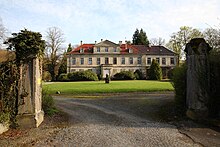Fulda-Diemel-Weg
| Fulda-Diemel-Weg | |
|---|---|
| Data | |
| length | 64.6 km |
| Markers | |
| Starting point |
Kassel (Wilhelmshöhe) 51 ° 19 ′ 0.2 ″ N , 9 ° 25 ′ 24.1 ″ E |
| Target point |
Bad Karlshafen (train station) 51 ° 38 ′ 45.4 ″ N , 9 ° 26 ′ 43.9 ″ E |
| Level of difficulty | easy, normal |
| season | all year round |
The Fulda-Diemel-Weg is a main hiking trail designated by the Hessisch-Waldeckischer Gebirgs- und Heimatverein (HWGHV) in the Habichtswald Nature Park in North Hesse , as well as with short cross-border sections in North Rhine-Westphalia .
The path is a total of 64.6 km long and leads in a wide arc from Kassel - Wilhelmshöhe to the north-north-west through the Habichtswald to Laar , then in a general north direction via Niederlistingen to Ersen and finally generally north-east via Liebenau , Lamerden and Langenthal to Bad Karlshafen , where the Diemel in the Weser flows .
The Fulda-Diemel-Weg has the HWGHV designation "Weg F07" and is signposted with a white F on a black rectangle as a signpost.
course
The route begins in Wilhelmshöhe at the Wilhelmshöhe car park or the tram terminus “Wilhelmshöhe (Park)”. From there it goes first on the Ochsenallee to the northeast and north and then through a small forest area to Schanzenstrasse, on which the path turns west to Hessenschanze in the Kirchditmold district . It leads to the northwest, briefly touches Wolfhager Straße ( Bundesstraße 251 ) south of Weimar , and then continues mostly through forest over the high plateau of the Hohen Dörnberg west of the Hohlestein (476.6 m), later to the north on the towering basalt rocks of the Helfensteine (509.8 m) over. Shortly afterwards, the path passes in the natural area of Dörnberg and Schreckenberge to the northeast, past the extensive gliding area of the Zierenberger Kuppe , also known as Kleiner Dörnberg (481.6 m). The path then crosses the L 3214 state road and continues to the northwest through the forest, past the Kleiner Schreckenberg (474.7 m) and the Schartenberg castle ruins (389.5 m) on a western mountain spur of the Schartenberg (403.9 m).
To the east of Laar, the path turns to the west and goes over the warm and through the small hamlet of Laar with the old mill and the Laar castle to the west. On the other side of the Warmetal, it turns north again and leads east past the Malsburg castle ruins to Gut Sieberhausen . To the north of the farm, it follows the edge of the forest in a wide arc, first to the west and then to the north and reaches Niederlistingen , where shortly before the federal road 7 is crossed. After crossing the village, the path continues north to Ersen . Leaving this village to the northeast, the path goes again through forest and fields to Liebenau, through Liebenau and over the Diemel, then further north, crossing briefly to North Rhine-Westphalia, and finally turns to the northeast and east until it reaches Lamerden. Through the village it continues to the north, east past Muddenhagen , then about 2 km along the Hessen-NRW border through forest in a north-east direction, then east around the Deiselberg (389 m) with its crater pond, bending north, and through Langenthal . Now it goes again through the forest to the north, until just over the border to North Rhine-Westphalia , and then still in North Rhine-Westphalia sharply bend to the east to Herstelle an der Weser, which is bypassed on the southern edge of the residential area. From there the route runs in an eastward direction in the North Rhine-Westphalia region to Bad Karlshafen, which is again in Hesse. There the last section goes over the Weser bridge to the parking lots at the train station.
Elevation profile
The entire hiking trail runs from Kassel to Bad Karlshafen across fields, forests and hiking trails or paths .
The route is mountainous, but not strenuous. The steepest sections have a gradient of around 4%. Over the first 10 km a total of about 250 m difference in altitude has to be overcome, whereby the highest point of the hike is reached on the high plateau of the Hohen Dörnberg. Over the next 3 km, it first descends about 80 m and then goes up another 70 m. From km 13 to km 18 it is about 250 m generally downhill. The next 12 km go up and down four times, with a difference in altitude of up to 130 m from km 24 to km 27. There follows a 4 km long downhill section, on which it goes down about 160 m. On the next section between km 34 and km 40 it is initially about 150 m uphill for three km and then 160 m downhill again over the next 3 km. From km 40 to km 46, the route covers another uphill stretch with a total difference in altitude of 200 m, followed by a 3 km long downhill stretch with 180 m difference in altitude. Again it goes about 3 km uphill for about 135 m and then quite quickly on a 4 km distance 190 m downhill. Once again, from km 60 to km 63, a total of 90 m ascent has to be mastered. Then it goes 110 m downhill to Bad Karlshafen, with the last kilometer on a flat stretch through the city.
Web links
literature
- Bruno Mende: Hiking guide Grimm home North Hesse and neighboring areas. A. Bernecker Verlag, Melsungen 2010, ISBN 978-3-87064-137-5





